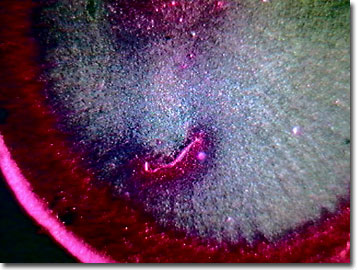Darkfield Digital Image Gallery
Bacterial Capsules
Similar to plant cells, bacteria are characterized by a protective cell wall surrounding the cytoplasmic membrane. However, some species of bacteria feature a third protective covering, the capsule, which is composed either of proteins, or more commonly of polysaccharides, a class of complex carbohydrates.

The capsule prevents desiccation of the bacteria and helps prevent phagocytosis by larger microorganisms and the white blood cells of invaded host organisms. Additionally, capsules help the bacteria adhere to the host substrate and assist in warding off attacks by viruses (bacteriophages). There are some indications that the capsule and its associated biofilms are toxic or chemically inhibitory to hosts' defenses, thus aiding the disease mechanism. For some pathogenic bacteria, such as the common Escherichia coli and Streptococcus pneumoniae, the virulence of a strain is dependent upon the function of the capsule. In contrast, non-encapsulated mutants of these prokaryotes are avirulent.
Because of the physical characteristics of polysaccharides, the capsule is also known as the slime layer of the bacteria. Some species of bacteria only excrete the slime layer, or capsule, under certain environmental and nutritional conditions, with the creation of a strong, prominent capsule associated with high concentrations of sugar. For some marine species of planktonic bacteria, the development of capsules portends an increase in grazing by flagellates, most likely because of added nutritional value for the predator, and the indication of elevated metabolic activity. Marine biologists are exploring differences in marine bacterial capsule formation in eutrophic upper water layers in contrast to much lower encapsulation rates found in bacteria from deeper, oligotrophic water layers. There is an indication that the capsules of marine bacteria may account for a significant percentage of the exopolymer production in the ocean and act as a major contributor to the oceanic dissolved organic carbon pool.
Recombinant genetic manipulations in bacteria may provide some evidence of the means by which an avirulent strain of bacteria becomes virulent and indicate the best potential vaccination strategies. Pharmaceutical treatments of virulent bacterial infections involving species with strong capsules might be directed toward the biochemistry of inhibiting or weakening the protective capsules and their structural polysaccharides. Vitamin therapy may also aid the destruction of the adhesive polysaccharide protective coating, making flushing with liquids more likely to be a successful strategy for ridding the gastrointestinal tract of unwanted pathological bacteria, and may explain the action of supplements such as lauric acid.
Contributing Authors
Cynthia D. Kelly, Thomas J. Fellers and Michael W. Davidson - National High Magnetic Field Laboratory, 1800 East Paul Dirac Dr., The Florida State University, Tallahassee, Florida, 32310.
BACK TO THE DARKFIELD IMAGE GALLERY
BACK TO THE DIGITAL IMAGE GALLERIES
Questions or comments? Send us an email.
© 1995-2025 by Michael W. Davidson and The Florida State University. All Rights Reserved. No images, graphics, software, scripts, or applets may be reproduced or used in any manner without permission from the copyright holders. Use of this website means you agree to all of the Legal Terms and Conditions set forth by the owners.
This website is maintained by our
Graphics & Web Programming Team
in collaboration with Optical Microscopy at the
National High Magnetic Field Laboratory.
Last Modification Friday, Nov 13, 2015 at 01:19 PM
Access Count Since September 17, 2002: 26979
Visit the website of our partner in introductory microscopy education:
|
|
